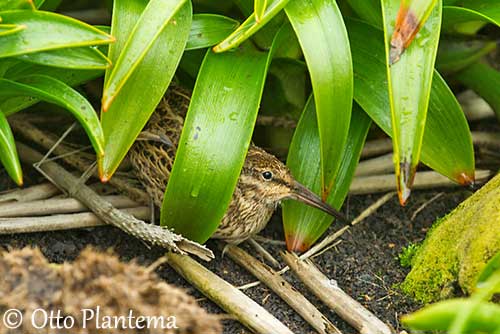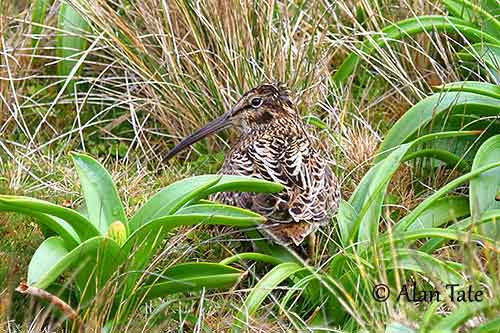
Fr : Bécassine des Auckland - Bécassine d'Auckland
Ang : Subantarctic Snipe – New Zealand Snipe
Maori : Hakawai
All : AucklandSchnepfe
Esp : Chochita de las Auckland
Ita : Beccacino subantartico
Nd : Aucklandsnip
Sd : Aucklandbeckasin
Photographer:
Otto Plantema
Trips around the world
Alan & Ann Tate
AA Bird Photography
Text by Nicole Bouglouan
Sources:
HANDBOOK OF THE BIRDS OF THE WORLD Vol 3 by Josep del Hoyo-Andrew Elliott-Jordi Sargatal - Lynx Edicions - ISBN : 8487334202
SHOREBIRDS by Peter Hayman, John Marchant and Tony Prater – Christopher Helm – 1986 – ISBN: 0747014035
BirdLife International (BirdLife International)
New Zealand bird status between 2008 and 2012
Wikipedia, the free encyclopaedia
Te Ara – The Encyclopedia of New Zealand
Subantarctic Snipe or New Zealand Snipe
Coenocorypha aucklandica
Charadriiformes Order – Scolopacidae Family
INTRODUCTION:
The Subantarctic Snipe is endemic to New Zealand subantarctic islands.
Like other snipes, this species is known for its special tail feathers. The strong outer rectrices can be pointed outwards, producing characteristic vibrating sounds during the plunge-dive which is part of the aerial displays. These feathers become quickly worn and may moult twice a year.
Following some change in taxonomy, the former subspecies C.a. huegeli from Snares islands is now considered as full species, whereas C.a. iredalei from South Island and C.a. barrierensis from North Island are considered extinct. Snipes are extinct on mainland New Zealand. The subspecies are endemic to their own islands.
DESCRIPTION OF THE BIRD:
Biometrics:
Length: 23 cm
Wingspan: 30-35 cm
Weight: 110 g
The adult of the nominate race has cryptic brown, black and buff plumage overall.
The hindneck is brown with dark streaks. Mantle and scapulars show brown feathers with blackish centre and buff fringes. Rump and uppertail-coverts are brown with faint barring. The short tail is brownish with faint barring, and the two pairs of outer rectrices are narrow and stiff. On the upperwing, wing-coverts and tertials are brown with indistinct bars and fringes. Rest of upperwing is brown with white-tipped greater primary coverts.
On the underparts, the chin is buff and unmarked, whereas neck and breast are buffish with brown spots and streaks. Flanks show brown markings. Belly, vent and undertail-coverts are pale brown and almost uniform.
On the head, the crown is brown with pale-edged feathers. We can see a pale buff stripe from top of the crown extending to the nape. There is a narrow dark brown eye-stripe from bill to eye. Supercilium and cheeks are buffish and spotted brown.
The long bill is brown with slightly paler base. The eyes are dark brown. Legs and feet may vary from yellowish-brown to greyish or greenish. The middle toe plus claw is about 8-10 mm longer than the tarsus.
Both sexes are similar, with female slightly larger than male.
The juvenile resembles adult with less distinct markings on breast and throat.

Plant species:
Bulbinella rossii
During the breeding season, the Subantarctic Snipe is highly territorial and may fight strongly with intruders. Typical aerial displays include a plunge-dive from considerable heights. During the dive, the vibrating outer rectrices produce distinct roar sounds. The display flights usually occur at night.
Courtship feeding by male to female is reported too.
The Subantarctic Snipe is sedentary with only local movements.
When disturbed, the bird rises a few metres on whirring wings. It may fly up to 50 metres before to pitch down quickly into the vegetal cover. It may move several hundred metres.
REPRODUCTION OF THIS SPECIES:
The breeding season takes place between August and January according to the island.
The nest is placed on the ground, hidden among the dense vegetation, often ferns. This is a shallow depression made in the leaf litter and debris of vegetation. This species is solitary nester.
The female lays 1-2 pale buff eggs with dark brown markings, at intervals of 3 days. Both adults share the incubation during about 3 weeks (21-22 days). At hatching, the chicks have brownish down with faint pattern. The brood is divided between the parents which feed the young during the first 3 weeks. They can fly at one month old, but they are independent only after 65 days.
This species produces a single brood, but the pairs may nest again after failure.
PROTECTION / THREATS / STATUS:
The Subantarctic Snipe suffered heavy predation by Pacific Rat (Rattus exulans), cats, pigs and Weka.
Two races, C.a. iredalei and C.a. barriensis are now extinct due to introduced predators.
However, the eradication of some of these predators from Campbell, Antipodes and Auckland Islands has involved the partial recovery of the populations. Other eradication actions are under way.
The race C.a. perseverance is considered as Threatened and Nationally Critical, with very small population.
The race C.a. meinertzhagenae is At Risk and uncommon.
The nominate race C.a. aucklandica is classified as Near Threatened, but its population is now stable. These birds are naturally uncommon in restricted range. Numbers are unknown.
SUBSPECIES AND RANGE:
There are three subspecies:
C.a. aucklandica (here described and displayed) is found on Auckland Island.
C.a. meinertzhagenae occurs on Antipodes Island. This race is darker with yellower underparts and grey legs.
C.a. perseverance is found on Campbell Island. This one is the smallest race. The back feathers are darker and the belly shows pinkish-buff wash.
This population is recovering thanks to eradication of rats in 2001 on Campbell Island.
HABITAT:
The Subantarctic Snipe frequents tussock grassland on cliff top and lightly-wooded areas. It remains under the vegetal cover during the day, and becomes much more active at dusk and night. It can be seen feeding in more open areas, often along the fringes of penguin colonies.
CALLS AND SONGS:
The Subantarctic Snipe utters a low “chup-chup” often heard at night. The female gives softer “chur”.
At night, they become more vocal during their aerial displays (hakawai) with a mix of vocal sounds and vibrating noises from wing and tail feathers.
BEHAVIOUR IN THE WILD:
The Subantarctic Snipe feeds on amphipods, insects, larvae and earth worms found in the ground. The bird probes the soil and the bases of tussocks with its long bill.
It is often seen alone, or in pairs during courting, or an adult with a dependent chick. They remain in the dense vegetal cover during the day, although they may roost sometimes in sunny areas on warmer days.

Plant species:
Bulbinella rossii